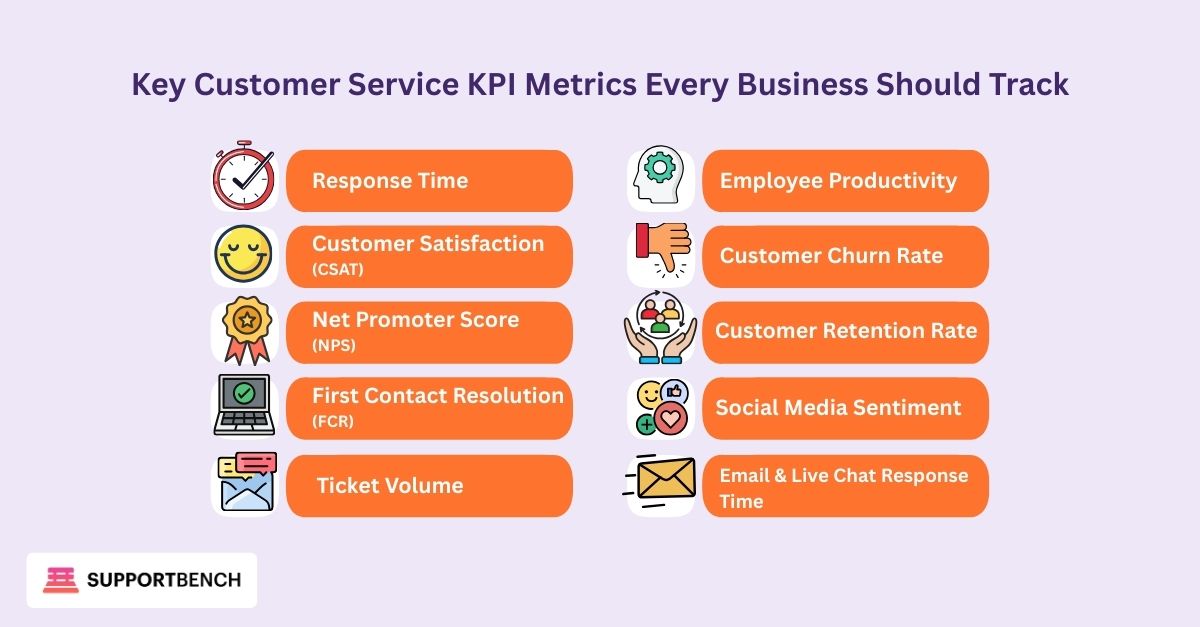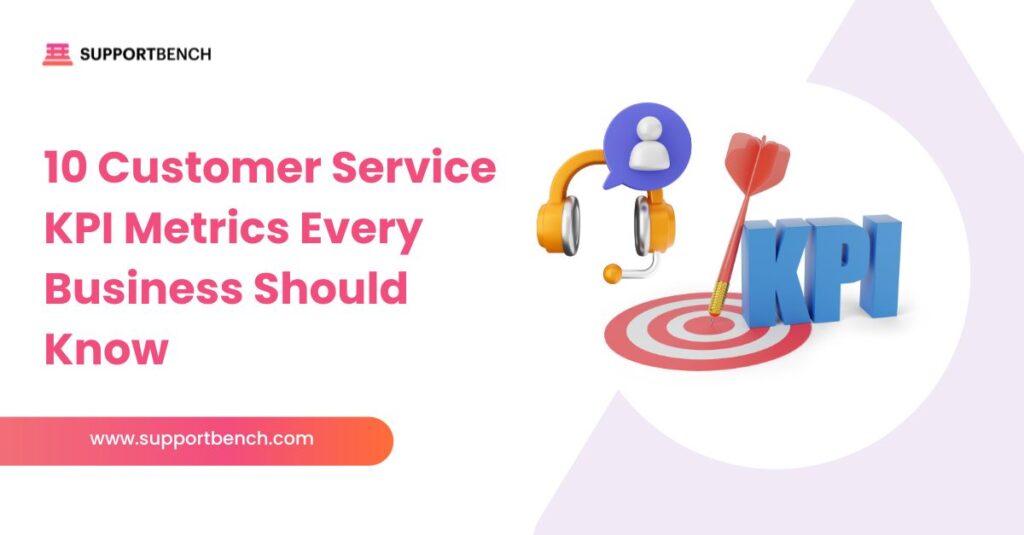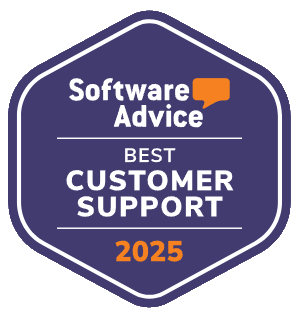Strong customer service depends on measurement. Without precise numbers, it’s difficult to know whether your support team is meeting expectations, keeping customers happy, and helping the business grow.
This is where Customer Service KPIs (Key Performance Indicators) play a crucial role. They provide a way to measure service quality, identify weak points, and connect support performance to overall business results.
At a Glance:
Track essential customer service KPIs like Response Time, CSAT, NPS, and First Contact Resolution to improve service quality, customer loyalty, and retention. Use these metrics to identify areas for improvement, set realistic goals, and align your KPIs with broader business objectives.
Avoid common mistakes like focusing on vanity metrics and neglecting customer feedback. Tools like Supportbench can help automate KPI tracking for better operational efficiency.
Customer Service KPIs: The Metrics That Matter

Key Performance Indicators (KPIs) are essential metrics that businesses use to evaluate their customer service performance. Customer Service KPIs measure how well a company is serving its customers, identifying areas for improvement, and guaranteeing that customer satisfaction remains high.
Response Time
Measures how quickly your team responds to customer inquiries across all channels. Faster responses improve satisfaction and reduce frustration.
Customer Satisfaction (CSAT)
Evaluates customer satisfaction with your products, services, and support through surveys or feedback forms, offering insights into overall service quality.
Net Promoter Score (NPS)
Assesses customer loyalty by asking how likely customers are to recommend your business. A higher score reflects strong advocacy and satisfaction.
First Contact Resolution (FCR)
Calculates the percentage of issues resolved in the first interaction. High FCR reduces repeat contacts and improves overall customer satisfaction.
Ticket Volume
Tracks the number of customer service requests received over a specific period. Helps identify trends, plan resources, and optimize service delivery.
Employee Productivity
Measures the efficiency of your customer service team in handling inquiries. High productivity ensures faster issue resolution and better service quality.
Customer Churn Rate
Indicates the percentage of customers who stop doing business with you. A high churn rate suggests issues with customer retention or satisfaction.
Customer Retention Rate
Tracks the percentage of customers who remain engaged with your business over time, signalling loyalty and the long-term value of your service.
Social Media Sentiment
Analyzes customer sentiment across social platforms to gauge how customers feel about your brand, helping you address concerns proactively.
Email & Live Chat Response Time
Measures how quickly your team replies to inquiries via email and live chat. Reducing response times across these channels leads to higher customer satisfaction and retention.
Some KPIs are predictive (leading indicators like CSAT or sentiment analysis that forecast satisfaction), while others are lagging (historical measures like churn or resolution time). Balancing both ensures you’re not just reviewing past performance but actively shaping future outcomes.
To dive deeper into how customer experience metrics shape service strategy, check out our guide on CSAT, CES, and NPS.
How to Use Customer Service KPIs to Improve Your Business

KPIs are not just numbers—they are signals that guide action. Each KPI can be tied to a business outcome.
Using KPIs for Root Cause Analysis
KPIs can point to recurring problems. For example, if ticket volume suddenly rises, the root cause might be a product bug, unclear instructions, or seasonal demand. Analyzing trends allows support teams to act quickly before issues grow larger.
Why Faster Responses Improve CSAT & Retention
Response time is one of the strongest indicators of customer satisfaction. Customers who receive help quickly are more likely to remain loyal and less likely to switch to a competitor. Reducing first reply time can directly improve CSAT and retention.
How Employee KPIs Drive Service Quality
Employee-related metrics, such as resolution ownership, training completion, or adoption of tools, show how prepared and engaged team members are. Strong internal KPIs translate to higher-quality customer interactions.
Tracking KPIs That Signal Customer Lifetime Value
Some KPIs, like Net Promoter Score (NPS) or churn rate, help predict customer loyalty and lifetime value. Monitoring these numbers allows businesses to plan for retention instead of reacting after customers leave.
Measuring Real-Time Customer Sentiment with KPIs
Customer conversations on social media and live chat can be analyzed with sentiment-based KPIs. These give businesses real-time feedback on how customers feel, helping managers respond before negative sentiment spreads.
How to Set Realistic Customer Service KPIs

When setting KPIs, businesses need to create a structured approach that aligns with broader goals.
Align KPIs with Business Goals
Start by linking KPIs to overarching business objectives, such as Customer Lifetime Value (CLV), Net Revenue Retention (NRR), or customer loyalty. For example, prioritizing Customer Retention Rate can directly affect profitability and long-term success.
Understand Customer Expectations
Customer expectations vary depending on the industry. For instance, a luxury brand may focus on high personalization and swift responses, while a budget service may emphasize cost-efficiency.
Aligning your KPIs with industry benchmarks ensures that you meet and exceed customer expectations.
Set SMART Goals
Create specific, measurable, achievable, relevant, and time-bound goals using the SMART framework:
- Specific: Aim for clear objectives like improving response time.
- Measurable: Track progress with metrics like a 15% decrease in Average Handle Time (AHT).
- Achievable: Set challenging yet attainable targets.
- Relevant: Make sure goals align with both customer needs and business outcomes.
- Time-bound: Establish deadlines, such as improving CSAT by 10% within six months.
Benchmark Performance
Compare your KPIs with industry standards or competitors to gauge your performance. This helps to set realistic targets and measure progress. Benchmarking provides valuable insights into where your business stands in comparison to others.
Use Data to Refine KPIs
As customer preferences evolve, so too should your KPIs. Continuously collect data from customer feedback, market trends, and internal performance to adjust your KPIs. This iterative process allows businesses to remain competitive and responsive to changes in customer expectations.
Common Mistakes to Avoid When Tracking KPIs
![]()
Monitoring KPIs is crucial for optimizing customer service, but some common mistakes can limit their effectiveness. Avoid these to maximize the value of your KPIs:
Focusing on the Wrong Metrics
Focusing too heavily on vanity metrics like Average Handle Time (AHT) may lead to rushed service. It’s essential to balance efficiency with high-quality support to provide an excellent customer experience.
Ignoring Customer Feedback
Metrics such as CSAT and NPS provide valuable insights into customer satisfaction. Ignoring this feedback means missing opportunities for improvement. Always ensure feedback is part of your KPI strategy.
Setting Unrealistic Targets
Setting targets that are too ambitious can demotivate your team or lead to unrealistic expectations. Use historical data and industry standards to create attainable goals that challenge your team without overwhelming them.
Failing to Act on KPI Data
KPI data is only valuable if it leads to action. Regularly analyze your KPIs and implement changes based on the insights you gather. Ensure that there’s a process in place for translating data into practical improvements.
Leveraging KPIs to Enhance Your Customer Service
Tracking customer service KPIs like First Contact Resolution (FCR), Customer Satisfaction (CSAT), and Net Promoter Score (NPS) is vital for improving service quality and team performance.
However, it’s crucial to avoid focusing on irrelevant metrics, ignoring feedback, or failing to act on insights. Tools like Supportbench’s AI-powered solutions help track key metrics, automate tasks, and streamline workflows for better operational efficiency.
By setting realistic goals and leveraging data, businesses can stay competitive and consistently meet customer expectations in today’s dynamic market.















